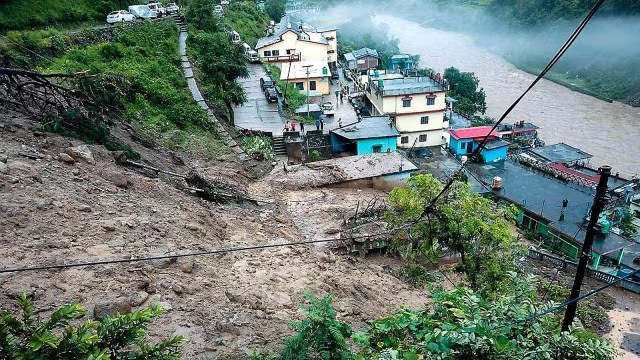Uttarakhand’s Chamoli Ravaged by Floods and Debris Flow, Two Missing and Villages Cut Off

Image Via The Indian Express
On the morning of August 23, 2025, Chamoli, a picturesque district in Uttarakhand, found itself at the mercy of nature’s fury. Continuous torrential rains had triggered catastrophic floods and massive debris flows across the region. At least two people have been reported missing, while several villages remain completely isolated, with transportation links severed and roads buried under layers of mud and rock. The flash floods and landslides have caused widespread devastation, with local authorities and rescue teams working relentlessly to aid those affected by the disaster.
The flood situation began to escalate on the evening of August 22, when the incessant rainfall hit the region’s hilly terrains. The overflowing rivers, particularly the Alaknanda, started inundating local settlements. As the water levels continued to rise, the riverbanks gave way, sending debris hurtling down the mountainsides, burying roads and homes under mud and rocks. Within hours, a disaster unfolded, displacing thousands and leaving many trapped in remote areas.
Torrential Rain and Its Aftermath:
The rains had started a few days earlier, but it was on the night of August 22 when they intensified, turning Chamoli into a flood zone. Over a 24-hour period, the rivers swelled to their limits, and the continuous downpour only made things worse. The steep slopes that dominate the region’s geography became unstable, leading to landslides that wreaked havoc on infrastructure. Key roads connecting villages to the rest of the state were damaged, and many houses were either flooded or destroyed by debris flows.
The destruction was not limited to homes but extended to agricultural lands. Farmers, who rely on the fertile land for their livelihoods, saw their crops washed away by the torrents. Fields that were once filled with greenery are now submerged in muddy waters, which could lead to food shortages and a significant economic downturn for the local communities.
The state of panic among residents was palpable. Villages, once peaceful and thriving, now stand cut off from the rest of the world. With roads buried under mud and communications disrupted, these remote settlements remain unreachable, making rescue operations even more challenging.
Ongoing Rescue Efforts:
In response to the alarming situation, local authorities, supported by the National Disaster Response Force (NDRF), State Disaster Response Force (SDRF), and the Indian Army, have launched extensive rescue operations. Despite the difficult terrain and harsh weather, teams have been dispatched to assist people trapped in their homes and evacuate them to safer areas. Helicopters have been employed to carry out aerial surveys and airlift people from areas where it is impossible to reach by land.
However, the sheer scale of the disaster and the ongoing rainfall have hindered rescue efforts. Flash floods and continuous landslides make it difficult for rescue teams to maintain a steady flow of operations. While some areas are already being cleared, others remain completely inaccessible, and the missing individuals are yet to be found.
The local police and administration are working around the clock to locate the two missing people. Officials have reported that these individuals were in the path of the debris flow and have not been heard from since the early hours of August 23. As rescue teams continue their work, the hope remains that these missing people can be located safely.
Life on the Ground:
For the residents of Chamoli, the situation is a nightmare. Many villagers are living in fear of further landslides, and the constant rains have only escalated their anxiety. Without proper shelter, food, or drinking water, life has come to a standstill for these residents. Relief operations are underway to distribute food and other essentials, but with roads cut off, it’s proving to be a difficult task.
For many people in the district, the immediate concern is survival. As the rain continues, the fear of further devastation lingers. Villages in the higher reaches of the district are particularly at risk, as the unstable mountain terrain could give way to even more landslides and floods. Despite these challenges, locals remain resilient, and the community has rallied together to help those most in need.
The local administration has deployed teams to establish temporary shelters for displaced residents, but with no clear timelines on when things will return to normal, uncertainty looms large. Many residents have sought refuge on higher ground, hoping to escape the rising water levels.
The Bigger Picture:
Experts are now calling for an urgent review of disaster management and preparedness measures in the region. Uttarakhand, particularly its mountainous areas, is prone to natural disasters like floods, landslides, and earthquakes. Over the years, the state has witnessed devastating incidents caused by erratic weather patterns, yet many of the local infrastructures remain ill-equipped to handle such disasters.
There is also a growing concern over the environmental impacts of unchecked development in the region. With the increasing construction of roads and infrastructure in the fragile mountain ecosystem, the risk of natural calamities like landslides and floods has risen. Local communities, environmentalists, and policymakers need to work together to ensure sustainable development in these regions while taking adequate precautions to minimize disaster risk.
A Long Road Ahead:
As the rain continues to fall and the rivers rage, the fate of Chamoli hangs in the balance. With authorities intensifying their rescue operations and relief efforts, there is hope that the situation will improve in the coming days. However, the scale of the damage is likely to have long-term effects on the local population, and the full extent of the destruction is yet to be determined.
The people of Chamoli, known for their resilience and strong sense of community, now face an uncertain future. The road to recovery will be long, and the damage to infrastructure, agriculture, and local businesses will take considerable time to rebuild. But with support from the government, local communities, and NGOs, there is hope that the region will rise again, stronger and more prepared to face the challenges ahead.